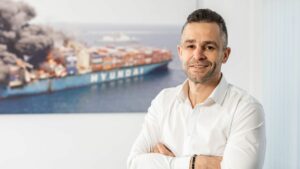Following the annual BTA Conference, Edwin Lampert from Riviera Maritime wrote an article on the presentation by the UK Secretary of State’s Representative for Maritime Intervention and Salvage (SOSREP) and React Emergency Response’s Dennis Kusters. The BTA extends its gratitude to the speakers and Edwin for their expertise and professionalism, which contributed to the success of the conference.

Emergency response protocols and co-ordination between authorities and salvage companies during marine incidents were discussed at the British Tugowners Association Annual Conference in Glasgow.
A session featuring presentations from the UK Secretary of State’s Representative for Maritime Intervention and Salvage (SOSREP) and a specialist expert marine firefighter was moderated by a leading UK towage operator with emergency response expertise.
SOSREP Stephan Hennig explained his role was created after the 1996 Sea Empress oil spill disaster off the coast of Wales. The Sea Empress incident highlighted shortcomings in the UK’s emergency response procedures and decision-making authority during major marine casualties. More than 72,000 tonnes of crude oil leaked after the Sea Empress tanker grounded, causing widespread environmental damage.
In response, the UK government established a new role to make time-sensitive decisions during marine emergencies on ministers’ behalf, without political delay. “I have a strategic oversight role but also indepth involvement in the operational response. It spans the whole spectrum, from operations through tactical to strategic oversight,” Mr Hennig explained.
Mr Hennig noted he usually only monitors situations if critical steps are being missed, then he can “ask probing questions or, if required, issue safety directions to vessel owners or offshore operators”. The goal is having clear decision-making to avoid repeating past response failures.
Emergency Response chief executive and serving marine firefighter Dennis Kusters said his company has three teams on standby 365 days a year, ready to respond to shipboard fires and dangerous cargo incidents. “For most incidents, we are there for up to eight weeks to get an incident under control,” he added.
Initial communication during maritime emergencies is pivotal and can present major challenges. Both Mr Kusters and Mr Hennig emphasised responders often lack critical information when they are first notified of an incident. For example, accurate passenger and cargo manifests detailing hazardous materials are essential for emergency crews to safely respond, but are frequently unavailable at the outset of an incident.
Without knowing what types of fuels, chemicals or other dangerous cargoes may be involved, third parties rendering assistance may be put at risk, getting too close to or attempting to board a stricken vessel. Mr Kusters gave an example of climbing aboard a burning container ship only to find explosive gases present, because there was no manifest indicating hazardous contents.
Once on scene, applying boundary cooling is a top priority to stabilise a casualty for boarding. “First we cool… then we try to control the fire. We do 24-hour shifts until we have the situation under control.” Mr Kusters cautioned against overzealous firefighting. “If you see flames, your first instinct is to throw all the water you can at it to suppress the fire. But you also must consider stability factors. If you start filling up cargo holds with water, you could be compromising the vessel’s integrity and stability and compound the situation.”
Even where there is co-ordination between different responders, it does not always go smoothly during an emergency, admitted Mr Kusters. “Even though we’re all trying to achieve the same outcome, lack of communication can lead to responders occasionally working at cross-purposes.” He cited a situation where the firefighting tug crew applied foam to suppress a fire, but then the coastguard helicopter inadvertently disrupted their efforts by dropping a pontoon into the foam, dissipating it. “You have to work together for a good outcome.”
Mr Kusters also cited an ammonia cargo fire where a lack of communication on severing a tow line quickly escalated an incident, but also impressed upon him “how crucial the tugs are in an emergency response”. Originally the situation was contained, and tugs were on standby. However, during the night a storm caused the tow line connection to snap. This suddenly compromised the vessel’s stability and integrity. Within 30 minutes, the cargo hold had filled with ammonia gas, making it unsafe for the crew to remain on board. With no tug support due to the severed tow line, the situation quickly escalated. There was an explosion in the engine room, and the crew was forced to abandon ship. The tugs were able to provide much-needed stability and boundary cooling to contain the incident.

Discussing emergency protocols, Mr Hennig explained how HM Coastguard co-ordinates rescues and alerts his agency to assess risks and mitigate impacts. Environmental scientists examine spill potential, fuels and cargo types to determine response needs. HM Coastguard’s Counter Pollution team sets up a marine response centre for longer incidents to co-ordinate pollution control and contracted responders. Throughout the response, his role is providing strategic guidance, seeking regular updates for ministers, and managing stakeholder expectations.
Both Mr Hennig and Mr Kusters strongly advocated more exercises to hone multi-agency response plans. “Whatever scenario you’ve designed, you want to involve as many relevant organisations and individuals as possible,” said Mr Hennig.
Questions from the floor addressed the emerging risk of responding to fires involving vessels operating on ammonia, hydrogen and lithium-ion batteries. Mr Kusters worried these new fuels may provide less time to contain incidents before dangerous escalation. Unlike traditional fuels, first responders have little real-world experience with fires involving alternative fuels. He stressed the need to “work together more efficiently than before,” when dealing with new fuel incidents, given the unknowns involved.
There are open questions about how these fuels burn, the firefighting techniques and agents that can safely suppress them, and the appropriate personal protective equipment needed. Lithium-ion battery fires can reignite hours or days after being apparently extinguished. Toxic fumes or explosive vapours resulting from these types of incidents also require different response precautions than traditional fuels.
Mr Hennig acknowledged alternative fuels present knowledge gaps for responders. “We have next to no baseline data on pollution response or safe response options,” he admitted. Both Mr Hennig and Mr Kusters agreed more research, planning and aligned procedures are urgently needed. They proposed training programmes must be updated to address new fuel risks. Doing exercises with these fuel types in advance is critical to develop expertise. Clear communication protocols must be established across tug crews, responders and vessel owners to co-ordinate an immediate, informed response. The shared view was the lack of familiarity with how to handle alternative fuel fires compounds the existing co-ordination challenges between multiple stakeholders. Without advanced planning, a fire could rapidly metastasize into a far larger-scale environmental and safety emergency.
Legal liability poses additional complexities during maritime emergencies. An audience member with extensive experience in salvage commented that salvors need to guard against overpromising contractually, as legal responsibility for any pollution ultimately falls to whoever is deemed in charge of the vessel. Even with the best intentions, a salvor must recognise their actions can attract liability.
There are well-documented cases of salvors facing accusations of negligence from the vessel owner and its insurers. The owner may claim the salvor made the situation worse through improper actions and want to recover huge sums for environmental damage and economic loss.
Mr Hennig explained he relies on contracted salvage experts with extensive expertise. He advised tug crews working as third-party firefighters to thoroughly assess risks and review contract terms ahead of time to help mitigate liability exposures when acting as a salvor. Clear communication protocols should be established and documented. Response plans should meet industry best practices. Proper training, equipment maintenance and transparent decision-making provide some protection if accidents occur. But legal exposure remains high for emergency responders. Maritime stakeholders, he said, should continue addressing liability concerns through improved contracts, insurance policies, international conventions and regulations that apportion responsibility fairly for unexpected incidents.
Another key topic was providing adequate emergency response assets regionally. Some delegates recommended restoration of greater state-owned emergency towing vessels. Mr Hennig acknowledged that “all our neighbouring countries operate state-contracted vessels”. Following a comprehensive spending review in 2010 which saw the demise of three of the four state-sponsored emergency towing vessels (ETVs), the UK continues to maintain one ETV which operates around the Northern and Western Isles of Scotland. The UK government conducts risk assessments at regular intervals to assess the requirement for tug provision around the UK’s coast.
Summarising the session and providing some key takeaways, the moderator, managing director of Targe Towing Ltd and the immediate past chair of the British Tugowners Association, Nick Dorman emphasised, “Emergency preparedness requires inter-agency training, processes and understanding roles. We also must evaluate if we have the equipment required for future incidents.”
A shared view was that regular exercises are vital to test plans across stakeholders, and it is essential to use these exercises to experience decision-making under pressure and build confidence. “Just expecting a logical, rational response [when there is a live incident] won’t work,” concluded Mr Dorman.
The article can be found on Riviera’s website here – Riviera – News Content Hub – Co-operation and contracted salvage expertise will overcome communication and knowledge gaps (rivieramm.com).
With gratitude to Edwin Lampert and Riviera for granting permission to the BTA to publish the article.


